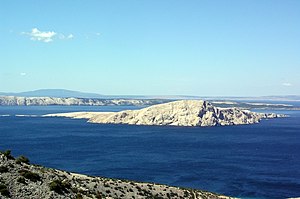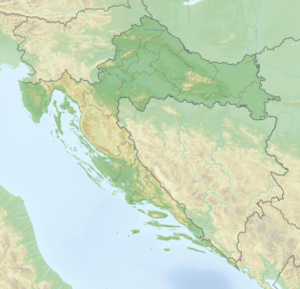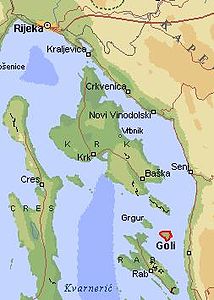Goli otok
| Goli otok | ||
|---|---|---|
| Goli otok | ||
| Waters | Adriatic Sea , Kvarner | |
| Geographical location | 44 ° 50 '18 " N , 14 ° 49' 7" E | |
|
|
||
| surface | 4.7 km² | |
| Residents | uninhabited | |
| Situation map | ||
Goli otok ( Croatian for "Naked Island") is a Croatian Adriatic island between the island of Rab and the mainland. It belongs to the Primorje-Gorski kotar County and covers an area of 4.7 square kilometers. The former prison island is now uninhabited, but can be visited by tourists.
The island is known for the re-education camp for political prisoners set up in 1949 by the Communist Party of Yugoslavia (KPJ) . As a result of the rupture of the Tito regime with the Soviet Union , followers of the Cominform known as “ Stalinists ” were interned, who were considered enemies of the people until the reconciliation with the Soviet Union after Stalin's death . More than 55,000 CPJ members were expelled from the party and many were arrested by the Yugoslav secret police UDB (from 1966 SDB) and the military intelligence service KOS . Between 11,000 and 18,000 of them were imprisoned on Goli otok (men's camp) and the neighboring island of Sveti Grgur (women's camp). Also some surviving Ustaša fascists . From around 1955 other alleged enemies of the state were also held prisoner.
The prisoners were used for forced labor in the quarries and workshops, tortured and killed. In 1988 the prison, also known as " Tito's KZ " or euphemistically "Tito's Hawaii " ( Titovi Havaji ), was shut down and completely abandoned in 1989, after which almost all movable objects were looted.
history
In the past centuries, the island of Goli otok was mainly used as grazing land for flocks of sheep. Some cisterns and temporary shepherds have been built on the island .
There were no settlements on Goli otok until the First World War . Austria-Hungary then set up a prison camp for Russian prisoners of war on the island during the war .
After the First World War it was taken over by the Italians who tried to mine on its bauxite , but this turned out to be unprofitable. Then a wholesaler from Brinje called Rade Vuković ran a sheep farm there again. In 1939, General Dušan Simović in the Kingdom of Yugoslavia had plans to set up a concentration camp for communists on the island , but these were not carried out.
Re-education camp and state prison of Yugoslavia
After the Second World War there was an expropriation, whereby the island came into possession of the now socialist state of Yugoslavia . After Yugoslavia was excluded from the Cominform and Tito's permanent break with Stalin, a prison camp for political prisoners was set up on it in 1949. The prison camp served first and foremost as a reception camp for Yugoslav supporters of the Soviet Union and Stalin and was therefore initially also considered a gulag for Stalinists . One of the main initiators for this idea was the then Yugoslav Interior Minister Aleksandar Ranković . The later party dissident and writer Vladimir Dedijer was also involved in the decision to build it there .
In the summer of 1949, Cominform supporters and fascists were the first prisoners to arrive on the island. From around 1955, other alleged enemies of the state were also held prisoner: social democrats , bourgeois , monarchists and westerners. In many cases, they were tortured and forced to make false self-accusations and sentenced to imprisonment on the hostile island.
After the work had previously been carried out in quarries, from the 1960s onwards the prisoners at Goli Otok produced terrazzo tiles and furniture, among other things .
Lawlessness, arbitrariness, terror and violence prevailed on Goli Otok. Mutual denunciations among the prisoners offered opportunities for easier detention or even release. Detainees were forced to do heavy physical labor regardless of the weather and were also subjected to regular abuse by guards. Thousands died from torture and abuse.
The prisoner transports took place without any food and without seats in cattle cars, which were brought from the interior by rail to the port of Bakar . From there they were brought to the island by ship, handcuffed and handcuffed, which took 5 to 6 hours, depending on the weather, and was carried out even during strong storms.
After the prisoners arrived on the island, they were beaten by the guards and the prisoners present. In addition, the newcomers were forced to sing praises and slogans in honor of President Tito. This sometimes led to absurd situations in which guards beat prisoners with whom they had been working in the same partisan unit a few years earlier during the war.
On the neighboring island of Sveti Grgur , a comparable prison, in which similar conditions prevailed, was originally built only for women.
Two years before the fall of Yugoslavia , the prison on Goli otok was abandoned.
management
In the early 1950s, the camp was headed by the Montenegrin communist Veselin Bulatović . In 1966, along with the head of the Yugoslav secret service, Aleksandar Ranković , the then camp director Slavko Barta was relieved of his post. In 1981 Anton Silić was the director of the camp.
Prisoners
A total of 16,500 people were imprisoned on the island. Most of the public enemies were shipped to the island without a trial. In addition to Stalinists and Ustaše, there were also workers, peasants, intellectuals, students and civil servants. The toughest opponents of the Tito regime remained on Goli Otok until 1985.
Processing in the literature
In 1960 the German-language brochure “In the Prisons and Concentration Camps of Yugoslavia” was published in the Socialist People's Republic of Albania , which dealt extensively with the camp and the torture on Goli Otok. The Croatian journalist Bruno Bušić published the book "UDBA archipelago: prison terror in Croatia" in the United States in 1976. (The UDBa archipelago: prison terror in Croatia). The autobiographical novel "Umiranje na obroke" (Death in installments) by the Slovenian ex-Dachau prisoner Boris Fakin was published in 1984 under his pseudonym Igor Torkar, with the support of the communist poet and World War II partisan Matej Bor at Delo in Ljubljana and at Globus Verlag in Zagreb . After his return in 1948, Fakin was sentenced to 12 years in a camp as an alleged Gestapo agent in one of the Stalinist show trials, the “Dachau Trials” of 1947/48. In the same year "Goli otok - The Island of Death" appeared in the USA, in which the Macedonian-Bulgarian writer Venko Markovski described the horrors of the prison island.
The poet Ligio Zanini (1927–1993), born in Rovinj , wrote his autobiographical work Martin "Muma" in 1990 about his time as a prisoner on the island. The Slovenian Branko Hofman wrote the book “Noć do jutra” (Night until morning) about his experiences as a prisoner on the island.
The first-person narrator in the novel “Alla cieca” (Blinds), by the Italian writer Claudio Magris, also reports on his time on Goli otok and the brutal prison conditions and torture there.
The Slovenian Drago Jančar reports on the region and the island in his volume of essays “Brioni”.
literature
- Martin Previšić: Povijest Golog otoka . Fraktura, Zaprešić 2019, ISBN 978-953-266-988-6 (Croatian).
- Božidar Jezernik: Tito's gulag on the island of Goli Otok . Klagenfurt 2014 (Translated from the Slovenian and Serbo-Croatian by Karin Almasy).
- Georg Lux, Helmuth Weichselbraun: Dilapidated & Forgotten: Lost Places in the Alps-Adriatic Region . Styria Verlag, Vienna / Graz / Klagenfurt 2017, ISBN 978-3-222-13551-4 .
Web links
- GOLI OTOK "naked island". A tour of Tito's former prison island in the Adriatic, registration by email required
- Nicole Münnich: Tito's taboo "Hawaii". On the status of research on the Yugoslav camp island Goli otok and on the question of processing (PDF file; 349 kB)
- Picture gallery ( Memento from May 19, 2011 in the Internet Archive )
- Der Standard, September 20, 2010, Maria Sterkl, "Suddenly the Russians were angry"
- GOLI OTOK documentation
Individual evidence
- ↑ Holm Sundhaussen: Yugoslavia and its successor states 1943–2011: An unusual history of the ordinary . Böhlau Verlag, Vienna 2014, ISBN 978-3-205-79609-1 , p. 103 .
- ↑ a b c d Ivan Kosić: Goli Otok: najveći Titov Konclogor . "Adamić", Rijeka 2003, ISBN 953-219-126-7 .
- ↑ Miroslav Lazanski: Tito posle 30 godina . Politika, April 17, 2010
- ↑ a b Tito's Gulag. Retrieved April 20, 2020 (German).
- ^ Ilija Vukadinović: U more s njima . In: Borba , June 1, 1990
- ↑ Sofokli Lazri, Javer Malo: In the prisons and concentration camps of Yugoslavia . Tirana 1960, p. 87 (Translation of an article from the newspaper Zëri i Popullit from August 1960).
- ^ Radio Free Europe (Ed.): From the Research Departments of Radio Free Europe: Communist area . tape 2 . Radio Free Europe, 1966, p. 14 .
- ↑ Slobodan Stanković: Tito's legacy: the mortgage of the old struggles for direction of ideological and national factions (= volume 18 of studies on contemporary studies of Southeast Europe ). R. Oldenbourg, 1981, ISBN 978-3-486-51271-7 , pp. 128 .
- ↑ International Society for Human Rights (ed.): The Petition: Amnesty for all political prisoners in Yugoslavia . 1986, p. 33 .
- ^ Christian Wehrschütz, Focus on the Balkans: Bloody Past - Uncertain Future, ISBN 3-222-13427-8 , p. 111
- ↑ Sofokli Lazri, Javer Malo: In the prisons and concentration camps of Yugoslavia . Tirana 1960 (translation of an article from the newspaper Zëri i Popullit from August 1960).
- ^ Bruno Bušić : UDBA archipelago: prison terror in Croatia . [The UDBa archipelago: prison terror in Croatia]. Croatian Information Service, Arcadia (Ca.) 1976.
- ↑ Braving Life's Bitter Sorrows , Slovenia News v. 16 December 2003 (English) ( Memento of 29 April 2007 at the Internet Archive )




